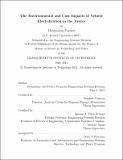| dc.contributor.advisor | Stephen Connors and Ignacio J. Pérez-Arriaga. | en_US |
| dc.contributor.author | Parness, Maximilian | en_US |
| dc.contributor.other | Massachusetts Institute of Technology. Technology and Policy Program. | en_US |
| dc.coverage.spatial | e-po--- | en_US |
| dc.date.accessioned | 2011-08-30T14:56:28Z | |
| dc.date.available | 2011-08-30T14:56:28Z | |
| dc.date.copyright | 2011 | en_US |
| dc.date.issued | 2011 | en_US |
| dc.identifier.uri | http://hdl.handle.net/1721.1/65432 | |
| dc.description | Thesis (S.M. in Technology and Policy)--Massachusetts Institute of Technology, Engineering Systems Division, Technology and Policy Program, 2011. | en_US |
| dc.description | This electronic version was submitted by the student author. The certified thesis is available in the Institute Archives and Special Collections. | en_US |
| dc.description | Cataloged from student submitted PDF version of thesis. | en_US |
| dc.description | Includes bibliographical references (p. 119-123). | en_US |
| dc.description.abstract | Electric vehicles (EVs) have the potential to reduce transportation sector CO₂ emissions in São Miguel, an island in the Azores, while simultaneously reducing mobility operating costs. This thesis attempts to quantify the cost and environmental impacts of using EVs on São Miguel, using an economic dispatch and unit commitment model. The number of EVs and the ways that they charge are varied. The composition of São Miguel's electric power generation portfolio is varied from its current composition to one that incorporates higher levels of renewable generation. Emissions reductions stemming from EVs vary according to how the vehicles are charged and when renewable generation, which is less expensive and less CO2- intensive than thermal generation, is available. Charging "optimally" can save hundreds of thousands of Euros in system mobility costs per week and, in some cases, halve transportation CO₂ emissions. Optimal charging results also show that, in certain cases, charging during periods of high electric demand is acceptable. This result is contrary to previous literature on vehicle charging, and is due primarily to the limited number of generators on S~ao Miguel. CO₂ abatement costs stemming from the use of EVs vary from 26 to 160 Euros per tonne of CO₂. Portugal's tax on gasoline and subsidization of EVs make calculating the exact cost of EVs in São Miguel difficult, but a simple discounted cash flow shows that, for a 950 electric vehicle fleet, the internal rate of return over a ten year period is 8.24%. Other costs associated with EVs, including the installation of new grid infrastructure and charging stations, are also considered. | en_US |
| dc.description.statementofresponsibility | by Maximilian Parness. | en_US |
| dc.format.extent | 123 p. | en_US |
| dc.language.iso | eng | en_US |
| dc.publisher | Massachusetts Institute of Technology | en_US |
| dc.rights | M.I.T. theses are protected by
copyright. They may be viewed from this source for any purpose, but
reproduction or distribution in any format is prohibited without written
permission. See provided URL for inquiries about permission. | en_US |
| dc.rights.uri | http://dspace.mit.edu/handle/1721.1/7582 | en_US |
| dc.subject | Engineering Systems Division. | en_US |
| dc.subject | Technology and Policy Program. | en_US |
| dc.title | The environmental and cost impacts of vehicle electrification in the Azores | en_US |
| dc.type | Thesis | en_US |
| dc.description.degree | S.M.in Technology and Policy | en_US |
| dc.contributor.department | Massachusetts Institute of Technology. Engineering Systems Division | |
| dc.identifier.oclc | 746765392 | en_US |
